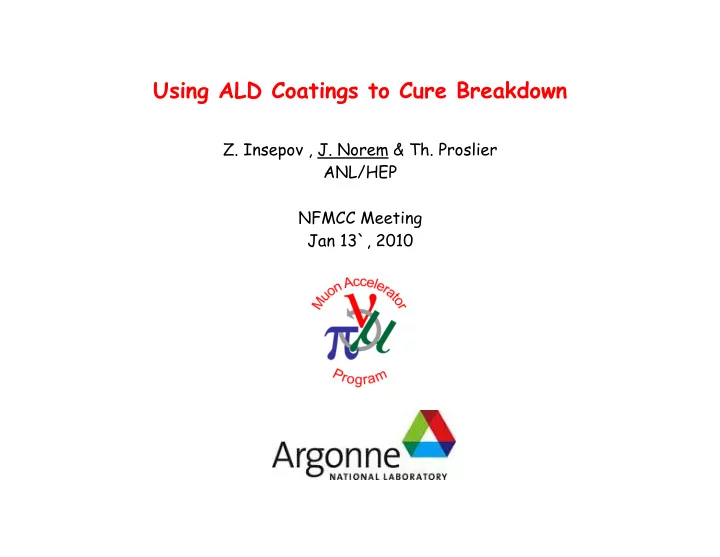

Using ALD Coatings to Cure Breakdown Z. Insepov , J. Norem & Th. Proslier ANL/HEP NFMCC Meeting Jan 13`, 2010
Arc Modeling at Argonne. • Starting in 2002, with support from ANL LDRD funds, we have been modeling arcs. • The original aim was twofold: 1) Learn how arcs worked so we could cure them 2) Bring additional funding (perhaps from the ILC) into the muon effort • The effort was not entirely successful: 1) We now have a solid arc model (the first?), and a potential cure for arcing. 2) We never got an additional penny from DOE for this work. • We are refining and extending the model, which seems to apply to all accelerator, and some plasma physics problems. • We find that a lot of other work seems to be based on misleading assumptions. (We’ve got a little list.)
Our breakdown model is basically simple. • Coulomb explosions trigger breakdown - fatigue (creep) and Ohmic heating help. • Breakdown arcs are initiated by FE ionization of fracture fragments. • The arcs are very small, dense, cold, and charged +(40-100) V, (OOPIC and V burn ). • Small Debye lengths, , produce fields, E = φ / λ D ~ GV/m. • High electric fields produce micron-sized unipolar arcs. • Unipolar arc energy produces craters and cracks with high field enhancements.
The model describes many aspects of arcs.
Microphotos of pits in the Cu plate from pillbox.
Surfaces are highly damaged.
McCrone SEM of Cu on Be.
Bob Rimmers multifocus camers.
SEM picture of pit in copper plate.
Profilometer measurements by Genfa Wu
The damage is not entirely random.. Things are chaotic at large dimensions, smoother at smaller ones, & structure ~ 2 µ m. Setting electric pressure = surface tension gives an equilibrium.
Cooling, cracks and β ’s: • Melted copper (~3 µ m thick, at ~1000 degC ) cools and cracks. Crack width: dx ~ (17 x 10 -6 ) * 1000 * x ~ 2% x, x = 10 µ => dx ~ 0.2 µ . Can be modeled by a cone. • Corners are atomically sharp, have high β s, and there are lots of them.
Field emission microscope measurements show high β s.
There is a spectrum of enhancement factors. • Everyone sees roughly the same thing.
Smoothing the surface should make cavities “Breakdown Proof”. • What is the effect of increasing the emitter radius? • This argument is scale invariant.
Field emission goes like E 14 .
Breakdown rates go like E 30 .
ALD can extend common sense to the nanoscale. • We would never tolerate random cm or mm scale sharp points in cavities. • We do have many asperities with radii ~4 – 10 nm, which we cannot remove. • Conformal coatings can eliminate small radii. • Since I FN ~ E 14 , and BDR ~ E 30 , and E ~ 1/r, increasing the radius of nano-asperities by a factor of three would reduce I FN by ~ 10 7 and the BDR by ~ 10 14 . • Atomic Layer Deposition can produce conformal, conducting coatings of a number of materials. - These coatings have been demonstrated at ~75 MV/m in SRF structures. - The primary experimental problems are associated with power couplers etc. - Tungsten seems to be the best thing to try first.
“Breakdown Proof”: proof-of-principle and RF cavity tests • The primary questions are the radius of the asperities, and deposition chemistry. • We are considering an experiment that uses pre-sharpened pins that we can sequentially coat and measure the field emission current. Depositing a known thickness of material conformally on the tips we should be able to “turn off” field emission, and measure the radius of the emitter (breakdown site). • We can also do this in-situ in a cavity. The experiment would involve - First: Condition the cavity & measure the dark currents at maximum gradient. - Then: Coat the cavity with ALD using known thickness of different metals. - Measure the field emission as a function of ALD coating thickness. • The cavity might look like this.
Recommend
More recommend